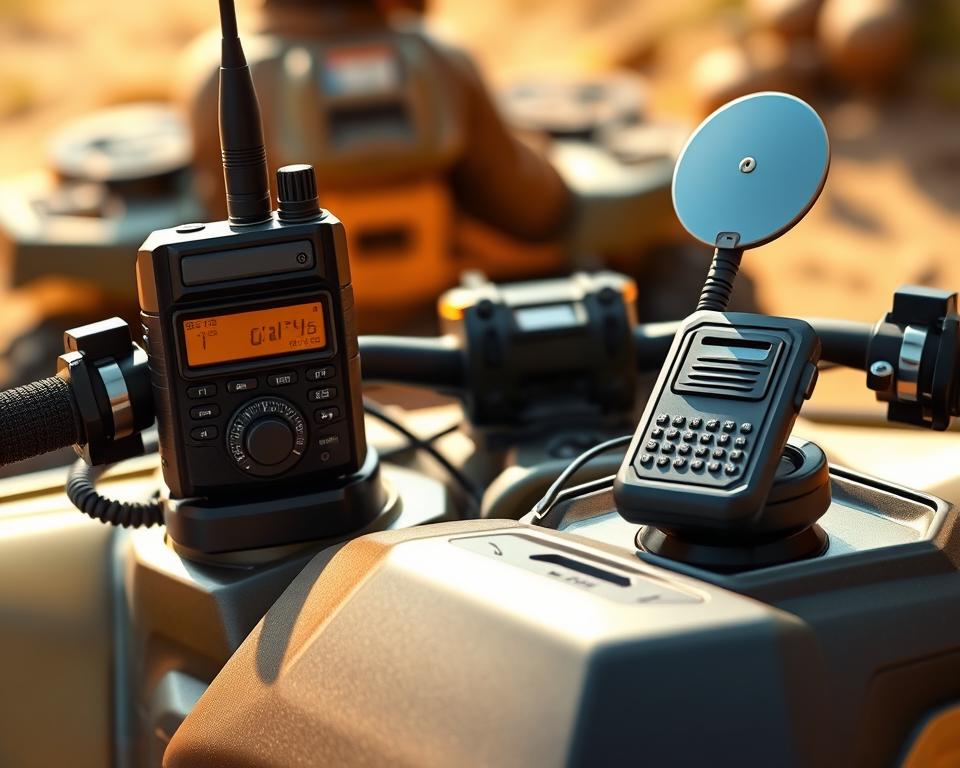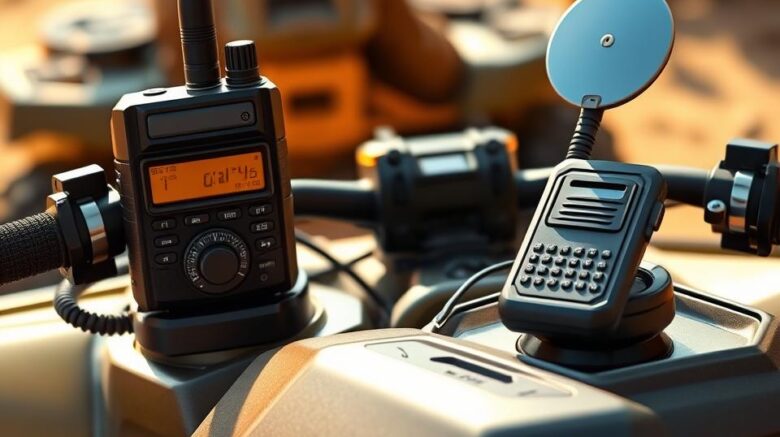Complete ATV Off-Road Safety Prep Guide
Were you aware nearly about 450,000 ATV-related injuries are treated in U.S. emergency rooms each year? Such a high number stresses the importance of being prepared and safe on the trails. Here’s your go-to ATV Off-Road Checklist for maximum safety and enjoyment. It covers everything from rocky trails to sand dunes. Equipped with top safety gear plus can-am snow plow necessities, you’ll ride safer and with more confidence.
Summary Highlights
- Prioritize safety by using the Essential ATV Off-Road Checklist for optimal preparation.
- Your gear list is critical for staying protected off-road.
- Maintenance matters: check often, ride better.
- Stay fueled and hydrated for peak performance.
- Don’t wander: rely on trusty navigation tools.
- Be ready for unexpected weather changes to stay comfortable during your adventure.
- Trailside fixes? Have your toolkit and recovery gear ready.
Understanding the Importance of Safety Gear
When you ride off-road, safety must come first. Riding an ATV is thrilling but comes with risks. Protective equipment shields you from crashes and bumps. Being well-equipped ensures a safer ride and follows an ATV safety gear checklist.

Essential Protective Gear
Maximizing protection involves several key items:
- Riding Helmets: Always use a DOT helmet to guard against head trauma.
- Goggles: Protect your vision with wraparound goggles.
- Gloves: Grip and guard your hands with sturdy gloves.
- Boots: Wear sturdy boots that cover the ankles to prevent injuries.
- Body Armor: Wear armor to guard your torso on rough trails.
- Neck Braces: Neck braces can help reduce the risk of spinal injuries.
Emergency Preparedness
Don’t overlook your emergency kit. An effective emergency kit can be a lifesaver in unexpected situations. Key items to include are:
- First aid kit
- Multi-tool
- Tire repair kits
- Portable air compressors
- Emergency blankets
- Whistles
- Matches
ATV Equipment for Optimal Performance
The right kit makes all the difference. Knowing the must-have ATV equipment ensures you’re ready for any journey. Routine checks keep your ATV working its best.
Must-Have ATV Equipment
- Durable Tires: Invest in tires designed for various terrains to improve traction and handling.
- Cargo Systems: Keep tools and spares within reach.
- Quality Fuel Tank: Opt for a robust tank to avoid drips and dry runs.
- Medical Kit: Be ready for scrapes and bruises with a first aid pack.
Regular Maintenance for Longevity
Establishing a consistent maintenance routine is vital. Regular inspections should encompass:
- A clean air filter = a happy engine.
- A well-lubed chain spins quietly and reliably.
- Inspecting brakes for safety before each ride.
Stay on top of upkeep and your ATV will perform its best.
The Essential ATV Off-Road Checklist
Don’t skip your pre-ride safety scan. A quick check prevents major headaches. Every point matters—don’t rush. A little prep goes a long way.
Pre-Ride Inspection Basics
Never ride without a quick systems check. This quick evaluation helps riders identify and address issues before they start. Key elements to check include:
- Tire pressure and tread condition
- Fluid levels such as oil and fuel
- Brakes and controls functionality
- Operational lights and horn
- Chain or driveshaft integrity
T-CLOC Inspection Method
Use T-CLOC for a thorough pre-ride check. Tires, Controls, Lights, Oil/Fuel, Chain—don’t miss a spot. This method ensures all critical areas are covered:
| Inspection Area | Checklist Items |
|---|---|
| Tires and Wheels | Check tire pressure, inspect tread depth, look for damage |
| Controls | Test brakes, throttle, and clutch for smooth operation |
| Lights | Ensure headlights, brake lights, and indicators are functioning |
| Oil and Fuel | Check oil level, inspect for leaks, and fill fuel tank |
| Chain/Driveshaft | Examine for wear, proper tension, and lubrication |
Spending a few minutes on this ATV maintenance checklist can make rides safer and more enjoyable. By checking these essential components, riders can avoid breakdowns.
Hydration and Nutrition for Long Rides
Stay fueled and hydrated for peak performance. Riders often underestimate their fluid needs, making it essential to plan ahead. Hydration packs make water access easy on the trail. Nutritious snacks power you through rough stretches.
Importance of Staying Hydrated
Hydration is critical for ATV riders to stay alert and capable throughout their journey. It’s important to drink water consistently, not just when thirsty. Backpack reservoirs keep water flowing hands-free.
High-Energy Snacks to Pack
Good snacks keep you sharp and energized. Opt for non-perishable items that are easy to consume. Some ideal choices include:
- Protein bars
- Nut mixes
- Dried fruits
- Beef jerky
Grab-and-go snacks let you refuel on the move. Ensure to pack a variety to keep your energy levels high and your taste buds satisfied.
Navigation Tools for Off-Roading Adventures
Lose fear of getting lost with the right nav gear. Off-road navigation tools are invaluable for staying on track, no matter the terrain.
Advanced GPS Systems
High-end GPS units guide you through the wild. GPS should work without cell service and last all day. Garmin and TomTom lead the pack for trail GPS.
Traditional Navigation Aids
Always carry a paper map along with your GPS. A compass never needs a signal. Map-and-compass know-how keeps you in control. Blend modern and classic for ultimate wayfinding.
Communication Equipment for Safety
When phones fail, two-way radios deliver. Using reliable ATV communication gear is vital for safety. Knowing you can call for help reduces stress.
For seamless communication among group members, a quality two-way radio is highly recommended. Pick units with strong, clear signal range. They allow for real-time updates on any changes or hazards. When choosing two-way radios, look for models with:
- Weatherproof construction to resist the elements
- Extended run-time for extended trips without needing a recharge
- Channel selection for clear communication without interference
Adding ATV communication gear to your adventure prep is essential. These tools improve interaction among riders and boost safety. When reception is zero, your radio still works. Stay connected, stay safe.
Self-Rescue Gear for ATV Riders
Self-rescue gear is as vital as your helmet. Self-rescue gear for ATVs is key to handling challenges on your own. Prepared riders make safer group members.
Winches and Recovery Kits
Winches are vital for self-rescue, helping pull your ATV from tough spots. Combine winch power with the right accessories. Recovery kits usually include:
- Tow straps
- D-rings
- Recovery boards
- Gloves
Understanding how to use this gear boosts ATV riders’ confidence in navigating rough terrain. Be ready for anything the trail throws at you.
Trail Recovery Essentials
Your toolbox should extend beyond the winch. These include:
| Equipment | Purpose |
|---|---|
| Recovery Straps | Used for towing or pulling ATVs out of tight situations. |
| Shovel | Helps clear obstacles and dig out vehicles when stuck. |
| Traction Mats | Provides grip under tires in muddy or slick conditions. |
| Portable Air Compressor | Enables quick tire inflation after deflating for better traction. |
Don’t rely on luck—bring the right tools. Skills plus gear equal top-tier off-road safety.
Staying Adaptable: Preparing for Weather Changes
Expect the unexpected in the outdoors. Your comfort and safety depend on proper weather prep. Don’t forget your layers and rain shell.
Layer up, shed as needed. Begin with a moisture-wicking base layer to manage sweat. Fleece or wool gives you warmth on demand. Finish with a rain-and-wind jacket. Stay dry and warm through all conditions.
Weather-Appropriate Clothing
- Rain Shells: A must-have for sudden downpours.
- Breathable Pants: Stay cool and dry with breathable pants.
- UV Gear: Lightweight, long-sleeved shirts and wide-brimmed hats safeguard against harmful UV rays.
- Cold-Weather Gloves: Insulate your hands against cold snaps.
Don’t let the weather ruin your ride. Stay focused on the trail, not on being wet or cold.
Tools for On-Trail Repairs
Having the right tools for on-trail repairs is key to a safe and enjoyable off-roading experience. It’s vital to carry reliable ATV repair tools. Fix flats and loose bolts in minutes.
Must-Have Tools and Kits
No ride is complete without a toolkit. This kit should include essential items for quick repairs. Critical ATV repair tools might include:
- Tire irons for changing flat tires
- Pliers for gripping and cutting
- Wrenches for various sizes of bolts and nuts
- A multi-tool for versatility
- Spare items such as spark plugs and electrical wire
- Duct tape for quick fixes
Tools at hand mean no surprises.
Basic Emergency Supplies
Tools alone won’t save you—bring these extras. These supplies help ensure your safety in challenging situations:
- First aid kit for injuries
- Flashlight with extra batteries for night-time visibility
- Emergency whistle for signaling assistance
- Reflective triangles or flares to warn other riders
- Water and high-energy snacks for sustenance
Preparation pays off big time. Always keep these ATV repair tools and emergency supplies handy.
The Final Word
Preparation is the secret to epic trails. Check off each item and pick reputable brands. Be set for rocks, sand, mud—anything.
With the right protective gear, navigation tools, and communication equipment, you’re set for safe riding. Prep wisely for peak thrills and protection. Focus on fun, not fears.
Gear up, stay sharp, and savor every off-road second. Your ride’s story begins with good prep. Use this guide for the best off-road experiences.
FAQ
What should I include in my ATV safety gear checklist?
Start with a DOT helmet and sturdy goggles. Add gloves, boots, and torso protection. Neck braces help guard your spine. Remember to pack an emergency kit with a first aid kit and multi-tools for preparedness.
How can I ensure my ATV is well-maintained?
Keep filters clean and chain well-lubed. Don’t ignore brake checks. Regular service keeps your ATV trail-ready.
Explain the T-CLOC check.
The T-CLOC inspection method covers several key areas. Tires, Controls, Lights, Oil, and Chain are checked in T-CLOC. This ensures your ATV’s critical components are in working order before hitting the trails.
How to gauge water needs off-road?
Carrying more water than you think you’ll need is essential. Accurately estimating hydration needs prevents fatigue, which is critical during long rides. Use a hydration bladder for quick sips.
Must-have navigation tools for ATV trips?
For navigation, invest in an advanced GPS system designed for off-road use. Combine this with traditional aids like waterproof maps and compasses.
Why is communication important when off-roading?
Effective communication is vital for safety and reassurance during off-road adventures. Radios work where phones don’t.
Essential recovery gear for off-road?
Every ATV rider should carry a winch and a detailed recovery kit. Include straps, shackles, and traction boards.
How to handle trail weather swings?
Layer up and down as conditions shift. Waterproof gear is necessary to stay dry during unexpected rain. Sun protection is also critical to prevent UV exposure.
What tools should I pack for on-trail repairs?
A compact tool set lets you fix flats and loose bolts. Include tire irons, pliers, wrenches, a multi-tool, and spare parts like a spark plug.
